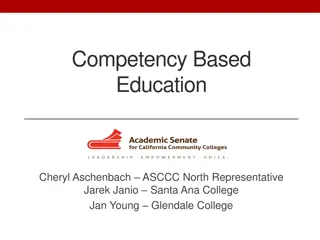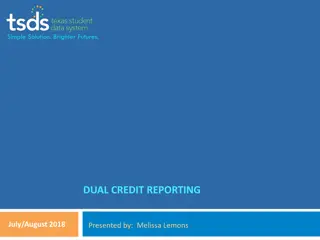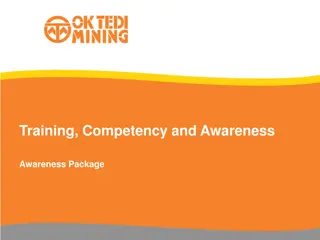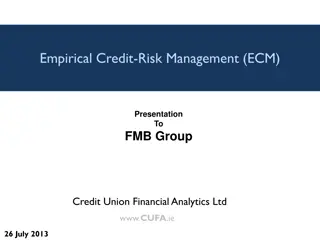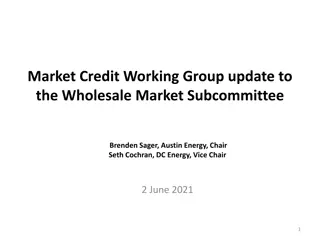Competency-Based Education & Credit for Prior Learning
Join this session to learn about proposed legislative updates and how colleges can provide students with opportunities for Credit for Prior Learning (CPL) through work-based learning and direct assessment of mastery.
Download Presentation

Please find below an Image/Link to download the presentation.
The content on the website is provided AS IS for your information and personal use only. It may not be sold, licensed, or shared on other websites without obtaining consent from the author. Download presentation by click this link. If you encounter any issues during the download, it is possible that the publisher has removed the file from their server.
E N D
Presentation Transcript
Competency Based Education & Credit for Prior Learning ASCCC Curriculum Institute 2023
Presenters Leticia Barajas, East Los Angeles College Randy Beach, Southwestern College Stephanie Curry, ASCCC Area A Representative Dr. Sigrid Williams, Norco College Terence Nelson, (via Zoom) CA MAP Initiative
Breakout Description Career technical education (CTE) has been given a boost by legislation and funding to close both the skills and employment gaps anticipated in California s future. While classroom instruction is a critical component of programs that prepare students for the general and job-specific demands of occupations, work-based learning through credit and noncredit work experience education, apprenticeships and competency-based education (CBE) are equally critical. Join this session to learn about proposed legislative updates and how your college may provide students an opportunity through Credit for Prior Learning (CPL) to be well-equipped to enter the workforce as aspiring employees by gaining on-the job experience through both credit and noncredit work-based learning and learning through direct assessment of mastery.
Direct Assessment CBE: Who Will Benefit? Current students: More than 800,000 currently enrolled students over age 25 of 2.1 million. Potential students: 6.8 million California workers aged 25-54 with high school diploma or some college but no degree 79% work 31 or more hours per week
Direct Assessment CBE: Who Will Benefit?
Whats the Why? Our students need freedom and flexibility from the rigidity of the Carnegie hour demands and arbitrary use of time as a measure of learning Direct assessment leads to more personalization of instruction at the student s pace Student self-pacing leads to more affordability for students Direct assessment promises more personalized student support from faculty and staff (case management approach) Students work with a trusted local institution rather than national provider CBE programs are developed with the local community workforce needs and the institution s equity mission in mind
The Direct Assessment CBE Pilot Eight colleges participating in design and implementation of a direct assessment CBE program since Summer 2021 Bakersfield College Coastline College East LA City College Madera College Merced College Mt. San Antonio College Shasta College Southwestern College Support from Jobs for the Future; Competency-Based Education Network (C- BEN); Volta Learning Group; Various CBE SMEs and practitioners, others
How Does Direct Assessment Work? Students enroll in a program of competencies, not courses Competencies are faculty-written statements of knowledge, skills, and abilities relevant to the discipline, often industry-recognized Learning is defined by demonstration of knowledge, skills, abilities and not seat time Demonstration of Mastery level of achievement of summative assessments for each competency is the required proof of learning Rigor is increased because mastery (or higher) is required for ALL competencies Students move as quickly or slowly as needed; moving quickly through content they understand, slower when more support is needed Students receive a competency transcript and a traditional course transcript
Whats different in CBE for Learners? Student Success Consideration Traditional DA CBE Impact on the Learner Equity: Access Synchronous Asynchronous (though program-dependent) Expanded (24/7) services and support Equity: Agency Faculty-centered Student/faculty partnership More clear expectations Pace of learning Deadlines driven by syllabus Self-directed with guide on the side Realistic milestones integrated with life Assignments Primarily summative Formative/summative Emphasis on feedback as teaching
Whats different in CBE for Learners? Student Success Consideration Traditional DA CBE Impact on the Learner Term Length Semester/quarter Student paced and self- regulated Honors knowledge, emphasizes planning Grading/Rigor Traditional Mastery (Y/N) or higher Learning is ensured at a higher level Progress (Dual Transcripts) GPA or course completion # of competencies mastered Learning more concrete/visualized Belonging Arbitrary groups in courses Day One access to like- minded peers Networking and social connections
Title 5 Regulations around CBE Series of regulations specifically for CBE ( 55270 - 55270.13) Considered Alternative Instructional Methodologies but much more Regulations define the following: CBE direct assessment definitions and standards of course-to-competency equivalence Program approval requirements Academic standards for local curriculum approval Faculty selection and workload Expectations for regular and substantive interaction Standards of student support for direct assessment instruction Grading and recordkeeping symbols Student repetition of instructional work Academic calendar requirements
Faculty Roles and Competency-Based Education CBE offers opportunity for new instructional models Faculty duties can be split across a team of faculty; referred to as unbundled faculty Faculty curriculum designers (writing competency statements) Faculty instructional designers (creating instructional content) Assessment faculty (formative and summative assessment) Coaching faculty (student progress monitoring and relationship-building) Others ? Requires reimagining of traditional approaches to faculty compensation and extensive professional development that supports collaborative work
Responsibilities of the Academic Senate Senates or Curriculum Committees, when delegated, develop standards for instruction and approval processes a)Competency approval (competencies are crosswalked to traditional credit-bearing courses) b)Documentation of program competencies c)Professional development needs d)Standards of regular and substantive interaction e)Program evaluation Senate involvement in general education conversation and graduation requirements expected in CBE programs Faculty leadership involved in conversations regarding transfer and the required CBE Transcript
Major Conversations for Your College Technology infrastructure for instruction (Canvas), tracking student enrollment, competency completion, and MIS reporting for funding Financial aid policies and processes for tracking satisfactory academic progress, aid disbursement and Return to Title IV policies (R2T4) Redirection policies to support students who decide to return to traditional courses without losing credit for the competencies they ve completed (requires curriculum crosswalks between competencies and traditional courses) Student supports for the nontraditional CBE student who works at their own pace Metrics for measuring success and impact will differ from traditional program evaluation
Resources What is Competency-Based Education? (C-BEN, 1:35 video) Title 5 Regulations for CBE 55270 - 55270.13 Competency-Based Education Network Canvas CBE Hub CBE vs. CPL Infographic and Article
BREAK Between CBE and CPL for Slide Purposes Only
Photo: https://www.freepik.com/premium-photo/students-friends-meeting-discussion-studying-concept_4404556.htm Credit for Prior Learning (CPL) Dr. Sigrid Williams, Ed.D., MPA CPL Coordinator, Norco College Associate Professor in ADJ Terence Nelson, MEd., MS Director of Academic Programs & Inst. P ships CA MAP Initiative
California Ed. Code, Title 5, Section 55050 (a) The governing board of each community college district shall adopt and publish policies pertaining to credit for prior learning. The policies shall be transparent and accessible to all stakeholders, published at least in college catalogs
California Ed. Code, Title 5, Section 55050 (d) Credit may be awarded for prior experience or prior learning only for individually identified courses with subject matter similar to that of the individual's prior learning, and only for a course listed in the catalog of the community college.
CSU CPL Policy - Article 3.A. Students shall be granted credit toward the degree for the following types of learning acquired outside of traditional higher education: 1.Completion of learning acquired outside traditional higher education, such as recommended by American Council on Education s National Guide. 1.Successful completion of other learning outside of traditional higher education that utilizes prior learning assessment methods such as portfolio assessment, attempted independently or as part of a course.
SCO Handbook Language/Title 38 (VA Benefits) "One of the criteria for approval of any school for Veterans' training is that it reviews prior credit and grant credit as appropriate to a VA student's current program. This is found in Title 38, Code of Federal Regulations, Sections 21.4253(d)(3) and 21.4254(C)(4). In essence, this requires every approved school to have and enforce a policy with regard to transfer courses, credits, and previous experience."
UC CPL Policy (Credit by Exam Preferred) UC may award lower-division (freshman/sophomore level) units for military courses completed if the courses are consistent with University policy on awarding transfer credit when there is an equivalent course taught at a UC campus. UC will consult the ACE recommendations for information regarding course content and as a guide to the awarding of credit. Credit for military courses is determined after matriculation at UC.
How CPL is Awarded Advanced Placement Examination (AP) International Baccalaureate Examination College-Level Examination Program (CLEP) Industry-Recognized Credential Student-Created Portfolio Credit by Examination in lieu of Assessment Approved
Impact on Students Equity Bump: Latinx +24%, Black +14% , Enrolled in community college +25%, Pell recipients +19% Reduced time to degree: 9-14 months Savings: $1,500 to $10,200. $68K for Vets. Completion Bump: 49% vs. 27% When analyzed in isolation, CPL increases the likelihood of higher ed completion by more than 17% in adult learners. Validation and Motivation!
CCCCO Vision for Success Core Commitments Alignment 1. Focus relentlessly on students end goals. 2. Always design and decide with the student in mind. 3. Pair high expectations with high support. 4. Foster the use of data, inquiry, and evidence. 5. Take ownership of goals and performance. 6. Enable action and thoughtful innovation. 7. Lead the work of partnering across systems.
MilCPL- The Ideal Start for CPL American Council on Education (ACE) Recommendations from Discipline Faculty Faculty Driven Proven Track Record Validation and Review Process Clear Recommendations
Equity and MilCPL Veterans Half of post-9/11 veterans say it was somewhat or very difficult for them to re-adjust to civilian life after military service. Only 25% of veterans believe they receive the college credits they deserve.
CA MAP Initiative and CPL Workgroup Efforts Broad group of CPL professionals from various systems including faculty, staff and administrators Meeting since Summer 2022 Recommendations and sharing of best practices Guide in CA MAP Initiative direction and trainings Recommend and advise on workgroups for policy and CPL crosswalks
Example: IBEW Electricians and Norco College Faculty determine that a certificate, license, course, work experience, portfolio, etc. is equivalent to college course(s). Based on work experience, Electrician Apprentice enters in year 4 of a 5- year certificate program. Equate work experience and training with required courses.
Example: ASE & Automotive Tech Pathways Faculty determine that a certificate, license, course, work experience, portfolio, etc. is equivalent to college course(s).
C-ID C-ID Descriptor This course introduces students to the characteristics of the criminal justice system in the United States. Focus is placed on examining crime measurement, theoretical explanations of crime, responses to crime, components of the system, and current challenges to the system. The course examines the evolution of the principles and approaches utilized by the justice system and the evolving forces which have shaped those principals and approaches. Although justice structure and process is examined in a cross cultural context, emphasis is placed on the US justice system, particularly the structure and function of US police, courts, and corrections. Students are introduced to the origins and development of criminal law, legal process, and sentencing and incarceration policies. C-ID Objectives Demonstrate an understanding of criminological theories used to explain crime and criminality; Explain the methods, theories, and concepts associated with the sources of crime data, the emerging patterns of criminal activity, and the costs of crime; Understand the history, development, and structure, and function of American police, courts, and corrections; Demonstrate an understanding of the history, structure, and function of the police; Convey an understanding of the process of adjudication; Show an understanding of corrections including the roles of probation, parole, and community corrections; as well as the functions of prisons and jails; Identify and describe special issues in the criminal justice system involving juvenile delinquency, drugs, and the future development; Critically analyze and discuss issues of crime and justice from varying perspectives; Utilize conclusions from scholarly research in creating informed positions on controversial issues in criminal justice; C-ID Content Understanding the Criminal Justice System Crime and Victimization Law Enforcement Courts and Sentencing Punishment and Corrections The Future of the Criminal Justice System Example AJ 110 Introduction to Criminal Justice
Course College SLOs 1. Analyze the Criminal Justice process from investigation through trial to appeal. 2. Examine and differentiate between an adversarial and inquisitorial system of criminal justice trails. 3. Distinguish at least three of the major significant differences between criminal and civil law. 4. Distinguish between the three major components of the criminal justice system in the United States and summarize the major responsibilities of each. 1 AJ 100 1. Demonstrate an understanding of criminological theories used to explain crime and criminality. 2. Demonstrate an understanding of the history, development, structure, function of the police. 3. Demonstrate an understanding of the process of adjudication from the role of prosecutor to the finalization of the trial process. 4. Demonstrate an understanding of Corrections, the function of jails, prisons, probation, parole and the community. 5. Critically analyze and discuss current issues and trends in crime from the perspective of the police, prosecutors, courts, corrections and the community. ADJ 1 A. B. C. Explain the history, structure, and function of the key components of the Criminal Justice System. Describe theories of crime and victimization, and discuss their overall costs. Discuss the future of the Criminal Justice System ADMJ 100 1. Analyze the major components of the U.S. criminal justice system. 2. Compare and contrast U.S. criminal court systems 3. Identify the processes by which a criminal case progresses from investigation to appeal. ADJU 101 A. Summarize and describe the fundamental aspects of justice administration, including familiarity with the history, development, and structure of the criminal justice system, using research methods to explore key aspects of course content. B. Compare, contrast, and discuss the functions and roles of the major components of the criminal justice system, including law enforcement, courts, and corrections, at the federal, state, and local levels, and the criminal justice systems of other countries. C. Analyze and assess the criminal justice system's effectiveness in crime prevention, peace-keeping, order maintenance, and the strategies being used to address a variety of contemporary community concerns, such as quality of life and social disorder. ADMJ 100 1. Upon successful completion of the course, the student will be able to identify and illustrate the orderly processing of cases through the justice system from investigation through appeal and exoneration; 2.Upon successful completion of the course, the student will be able to demonstrate a fundamental understanding of the core concepts of statutory criminal law as applied to case scenarios from both a prosecutorial and defense perspective. 3.Upon successful completion of the course, the student will be able to analyze the vital role that American constitutional values of due process, equal protection, and fundamental fairness play in policing, courts and corrections; 4. Upon successful completion of the course, the student will be able to identify and demonstrate a fundamental understanding of different cultural perspectives as they apply to the American Criminal Justice System. CRJU 1108
Example: POST Certificate/CPL Gaps Community Colleges with POST academies are not offering transferable credit classes for POST graduates. Community colleges with POST academies are offering non-transferable AA degrees. Four Academies are not tied to any community college 42 CA CCs offer POST while 99 CA CCs offer ADJ/CJ ADTs For Profit and Non-Profit Universities offer pathways for POST to transfer credit in for BA/BS degrees
Example Outcomes & Activities 1000+ JSTs in MAP Student Intake 41 of 76 colleges uploaded JSTs since May 2023 650+ ACE Courses Articulated or Pending Approval 150+ College Courses Articulated Statewide first responder credit recommendations underway Non-military CPL exhibit building underway
Upcoming Professional Development and Support from the CA MAP Team Check our MAP Webpage: https://map.rccd.edu Contact us via email Terence Nelson: terence.nelson@norcocollege.edu Dr. Sigrid Williams: sigrid.williams@norcocollege.edu 4th Annual CPL Summit- November 3rd 9am-1pm (zoom & no cost)
CCC Mission and CPL Mandate Mission: Educate for a Prosperous Citizenry At the Forefront in combating income inequality Are we maximizing CPL so adult re-entry students will access higher education and higher opportunities at a higher rate? Trailblazers in supporting social and economic mobility Are we recognizing prior learning and using it for an equitable and earned boost? Leading the way on workforce development by partnering with industry and labor to create innovative skills-building initiatives Are we integrating work-based learning and certifications in college pathways to save time, money, and improve ties to industry?
CPL Resources California Code of Regulations, Title 5, Section 55050 Credit for Prior Learning, Cal. Code Regs. tit. 5 55050 | Casetext Search + Citator California Community College (CCC) Chancellor s Office Memo on CPL: https://www.norcocollege.edu/services/enrollment/vrc/cpl/Documents/ESS-20-300-001- Credit-for-Prior-Learning.pdf California Community Colleges MilCpl Resource - Credit for prior learning California Community Colleges - MilCpl Resource - Credit for prior learning California State University (CSU) CPL Policy: https://calstate.policystat.com/policy/9817841/latest Statewide CCC CPL Board Policy Links: https://www.norcocollege.edu/services/enrollment/vrc/Documents/map/CCC-MilCPL- Resource-CPL.pdf University of California (UC) CPL Policy: https://admission.universityofcalifornia.edu/counselors/files/Transfer_Credit_Practice.pdf
CPL Resources Association of Community College and Junior Colleges (ACCJC) Policy on CPL: https://www.norcocollege.edu/services/enrollment/vrc/cpl/Documents/ACCJC- Policy-on-Credit-for-Prior-Learning-June-2020.pdf MAP Training Resources and FAQ: https://www.norcocollege.edu/services/enrollment/vrc/Pages/map.aspx Norco College CPL Policies and Resources: https://www.norcocollege.edu/services/enrollment/vrc/cpl/Pages/policy.aspx Academic Sentate of the California Community Colleges (ASCCC) Advocacy for CPL (Christopher Howerton): https://youtu.be/xXdJSFY5JPU Credit for Prior Learning: Leveraging Past Learning to Close Present-Day Equity Gaps: https://californiacompetes.org/resources/credit-for-prior-learning- leveraging-past-learning-to-close-present-day-equity-gaps/ Side by Side: Comparing Credit for Prior Learning and Competency-Based Education Side by Side: Comparing Credit for Prior Learning and Competency-Based Education | California Competes Noncredit Instruction: Opportunity and Challenge: https://files.eric.ed.gov/fulltext/ED602047.pdf
CPL Resources California Legislation Supporting CPL and MILCPL: 2012 Block AB 2462: Specified that by July 1, 2015, the Chancellor of the California Community Colleges (CCC), using common course descriptors and pertinent recommendations of the American Council on Education, shall determine for which courses credit should be awarded for prior military experience. This has not happened because of the complexity and enormity of the task, which must rely on discipline faculty experts at each of the 115 California Community Colleges to make articulation decisions for courses paired with ACE Recommendations one at a time and there are tens of thousands of combinations at each college. 2018 Cervantes AB 1786 Academic Credit for Military Experience: Specified that by March 31, 2019, the CCC Chancellor is to establish an initiative to expand military Credit for Prior Learning (CPL). The initiative was supposed to identify best practices for CPL, locate and collect available resources and provide professional development. The initiative also sought to identify the best practices for potential pilot programs and provide recommendations for internal system wide policy changes to expand CCC CPL. By January 1, 2020, the chancellor was to report to the Legislature on the initiative.
CPL Resources 2018 Roth CA S 1071 Community Colleges Uniform Policy to Award Credit: Requires CCC Chancellor to work with Academic Senate for California Community Colleges (ASCCC) to develop a consistent policy to award military personnel and Veterans who have an official Joint Services Transcript course credit for Intersegmental General Education Transfer Curriculum, State University General Education Breadth or local community college general education requirements. ASCCC Resolution 18.04 (2011): Urges local academic senates to apply credit for educational experiences during military service toward the associate degree including the fulfillment of general education, major coursework, certificates, and other degree requirements in accordance with the recommendations listed in the American Council on Education (ACE) Guide to the Evaluation of Educational Experiences in the Armed Services.


